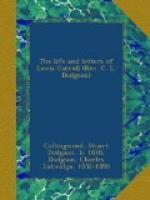[Illustration: Sir John Tenniel. From a photograph by Bassano.]
* * * * *
CHAPTER IV
(1868-1876)
Death of Archdeacon Dodgson—Lewis Carroll’s rooms at Christ Church—“Phantasmagoria”—Translations of “Alice”—“Through the Looking-Glass”—“Jabberwocky” in Latin—C.S. Calverley—“Notes by an Oxford Chiel”—Hatfield—Vivisection—“The Hunting of the Snark.”
The success of “Alice in Wonderland” tempted Mr. Dodgson to make another essay in the same field of literature. His idea had not yet been plagiarised, as it was afterwards, though the book had of course been parodied, a notable instance being “Alice in Blunderland,” which appeared in Punch. It was very different when he came to write “Sylvie and Bruno”; the countless imitations of the two “Alice” books which had been foisted upon the public forced him to strike out in a new line. Long before the publication of his second tale, people had heard that Lewis Carroll was writing again, and the editor of a well-known magazine had offered him two guineas a page, which was a high rate of pay in those days, for the story, if he would allow it to appear in serial form.
The central idea was, as every one knows, the adventures of a little girl who had somehow or other got through a looking-glass. The first difficulty, however, was to get her through, and this question exercised his ingenuity for some time, before it was satisfactorily solved. The next thing was to secure Tenniel’s services again. At first it seemed that he was to be disappointed in this matter; Tenniel was so fully occupied with other work that there seemed little hope of his being able to undertake any more. He then applied to Sir Noel Paton, with whose fairy-pictures he had fallen in love; but the artist was ill, and wrote in reply, “Tenniel is the man.” In the end Tenniel consented to undertake the work, and once more author and artist settled down to work together. Mr. Dodgson was no easy man to work with; no detail was too small for his exact criticism. “Don’t give Alice so much crinoline,” he would write, or “The White Knight must not have whiskers; he must not be made to look old”—such were the directions he was constantly giving.
On June 21st Archdeacon Dodgson died, after an illness of only a few days’ duration. Lewis Carroll was not summoned until too late, for the illness took a sudden turn for the worse, and he was unable to reach his father’s bedside before the end had come. This was a terrible shock to him; his father had been his ideal of what a Christian gentleman should be, and it seemed to him at first as if a cloud had settled on his life which could never be dispelled. Two letters of his, both of them written long after the sad event, give one some idea of the grief which his father’s death, and all that it entailed, caused him. The first was written long afterwards, to one who had suffered a similar bereavement. In this letter he said:—




